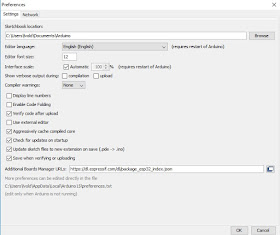I can not believe it is already 2 years ago that Espressif introduced and released the ESP32.
For those who live in the void a quick introduction.
Espressif is the manufacturer of the ESP8266 chips. And the successor of the ESP8266 is the ESP32.
Above you can see a picture of the ESP family. The ESP8266 on the left and the ESP32 on the right. The form factor is not all that different but the possibilities are. Both are breadboard friendly.
Pinout of the ESP32. Just look at all the posibillities. Click on the picture to enlarge.
Well at least that was, what I presume, the plan when they released the ESP32. However things not always go as planned. The ESP8266 has a large base in the hobby/tinkerer world and we did not embrace the ESP32 as quick as was expected. There are in my humble opinion several reasons for this.
- The ESP8266 is sufficient for most projects
- The ESP32 is much more expensive
- The ESP32 is more difficult to install
On the last point I want to elaborate.
No matter how fond I am of Basic as a programming language and it is my preferred rapid devellopment environment for the ESP8266, the most used programming environment is undoubtedly the Arduino IDE. However installing the ESP32 into the Arduino IDE was (up to now) a painstaking tedious undertaking.
Considering these points it is understandable that most hobbyists stay with the ESP8266 notwithstanding the benefits of the ESP32.
However there might be a change coming up.
First the price of the ESP32 is dropping. A board comparable to the NodeMCU is now priced at about 4 Euro/USD at our chinese suppliers with free shipping !!!
https://nl.aliexpress.com/wholesale?minPrice=3.83&maxPrice=&isBigSale=n&isFreeShip=y&isNew=n&isFavorite=n&shipCountry=UK&shipFromCountry=&shipCompanies=&SearchText=esp-32&CatId=0&g=y&SortType=price_asc&initiative_id=SB_20180815111942&needQuery=n&groupsort=1
Next to that the Installation of the board in te Arduino IDE got simplified in such a way that you can install it in a few minutes and as easily as an ESP8266.
Before I show you how to install it, let's look at a few of the benefits of this board:
- running at 160Mhz (or 240 Mhz) thats double the speed of the ESP8266
- 520KB ram
- Wifi AND Bluetooth
- 18 channel ADC
- 10 capacitive touch pins
- 4 SPI interfaces
- 2 i2s interfaces
- 2 i2C interfaces
- Can Bus
- 16 PWM channels
It is obvious that the ESP32 should get more attention as there are far more possibillities with this module as with the ESP8266 especially now the price is so attractive.
Installing the ESP32 the easy way
I'll show you how to easily install the ESP32 boards in the Arduino IDE.

First go to https://www.arduino.cc/en/Main/Software and install the lastest version of the IDE on your computer. At this moment in time that is version 1.8.5

When installed open the Arduino IDE and from the file menu choose preferences (highlighted here).

In the preferences in the last line which is the Additional Boards Manager URL's copy the following URL:
https://dl.espressif.com/dl/package_esp32_index.json

Now open the boards manager which can be found in the tools menu under board.

In the boards manager look for ESP32 by Espressif systems.
As you can see in my version I already installed but you will get the option to Install. So choose install and see the magic happen.
First test
When installing has finished we can test the board.
Attach your ESP32 with an USB cable to your computer. Choose the right COM port just like you are used to do with the ESP8266.

From the Examples in Communication choose ASCII-Table. Compile and upload it withe the arrow symbol at the left top of the IDE.

Next open the Serial monitor at 9600 baud and see your first program run.
That's all.
Now you can easily start devellopping ESP32 programs with the ESP32.
Life just got a lot easier !!!
Projects with the ESP32 will be coming up in the future, so please visit this blog often.
Till next time
Have fun
Luc Volders


